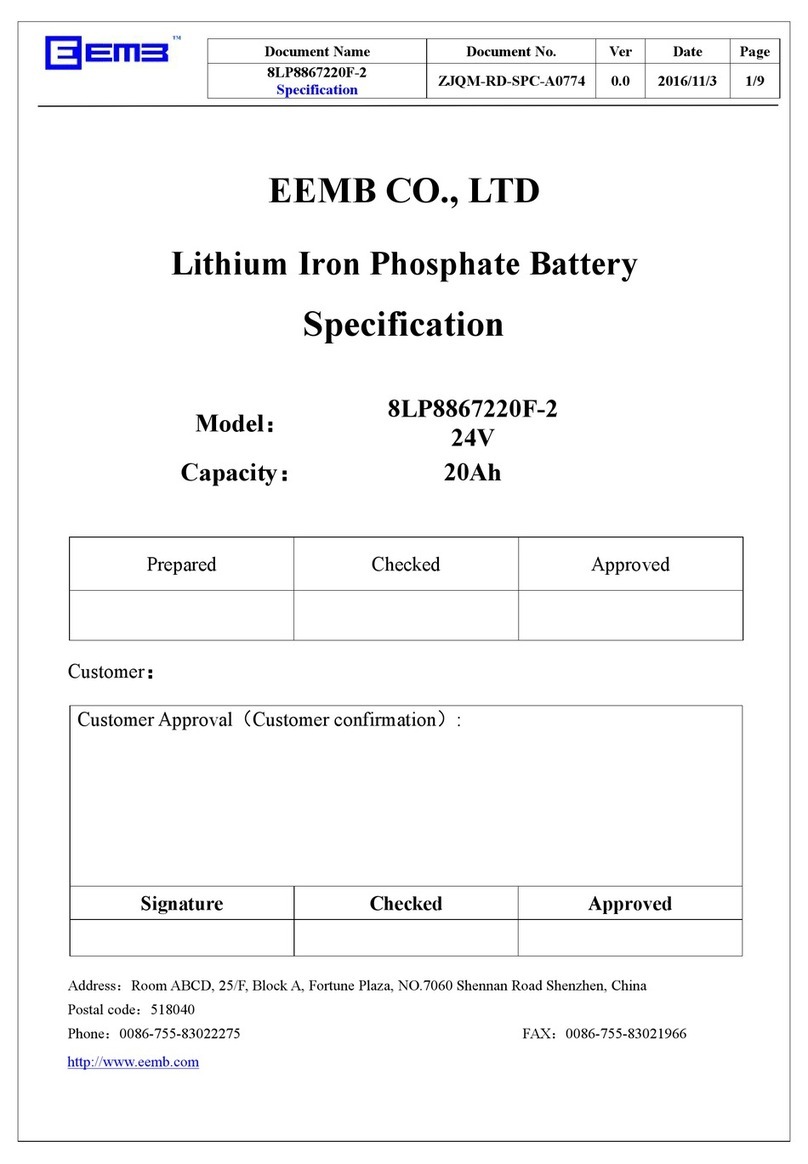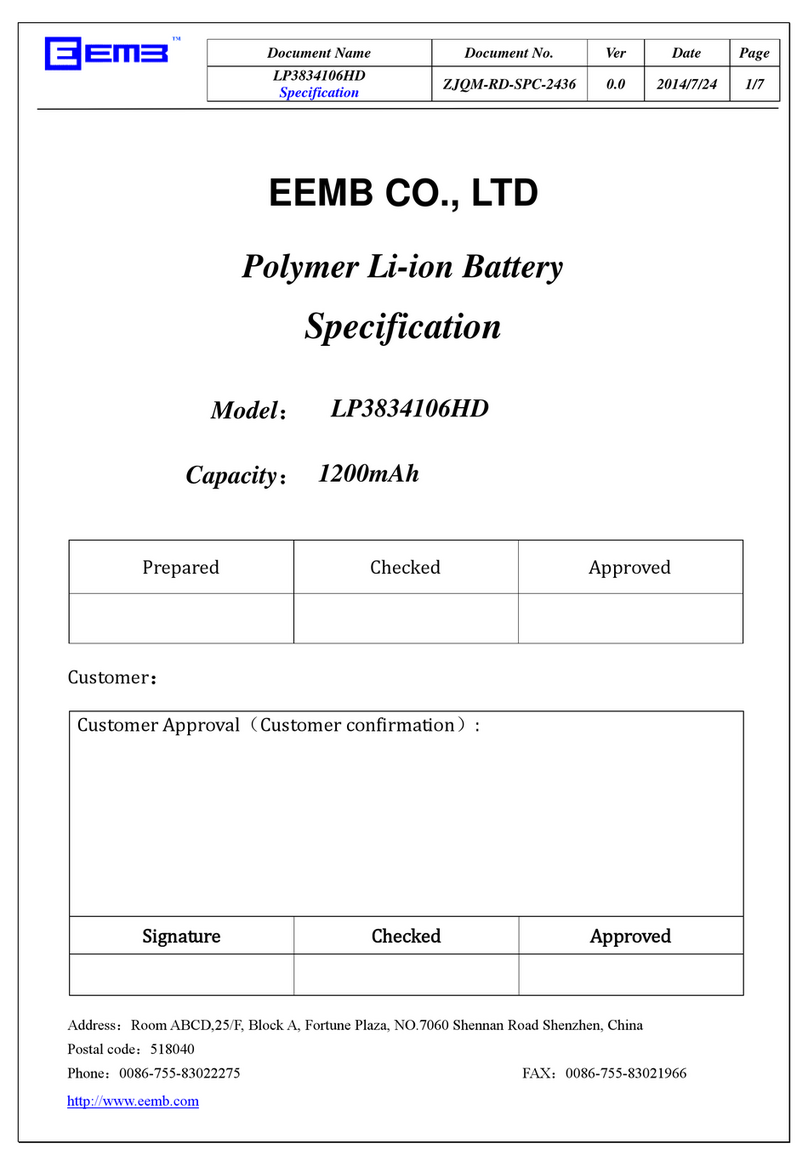EEMB LIR18650 User manual

Document Name
Document No.
Ver
Date
Page
LIR18650
Specification
ZJQM-RD-SPC-A12112
0.0
2017-8-28
1/9
EEMB CO., LTD
Li-ion Battery
Specification
Model:
LIR18650
Capacity:
2600mAh
Prepared
Checked
Approved
Customer:
Customer Approval(Customer confirmation):
Signature
Checked
Approved
Address:Room ABCD,25/F, Block A, Fortune Plaza, NO.7060 Shennan Road Shenzhen, China
Postal code:518040
Phone:0086-755-83022275 FAX:0086-755-83021966
http://www.eemb.com

Document Name
Document No.
Ver
Date
Page
LIR18650
Specification
ZJQM-RD-SPC-A12112
0.0
2017-8-28
2/9
1. Scope
This product specification defines the requirements of the rechargeable lithium-ion battery supplied to the
customer by EEMB Co., Ltd.
2. Battery Cell Basic Performance
No.
Item
General Parameter
Remark
1
Nominal Capacity
2600mAh
Standard discharge(0.2C)
Cut-off voltage: 3.00V
Minimum Capacity
2550mAh
2
Nominal Voltage
3.7V
Mean Operation Voltage
3
Voltage at end of
Discharge
3.00V
Discharge Cut-off Voltage
4
Charging Voltage
4.2V
5
Open Voltage
3.7~3.9V
6
Load Voltage
≥3.6V
10Ω
7
Energy
9.6Wh
8
Internal Impedance
≤150mΩ
AC 1KHZafter 50% charge
9
Standard charge current
520mA
10
Standard discharge current
520mA
11
Maximum Charge Current
2600mA
Ambient temperature 0-40℃
12
Maximum Continuous
Discharge Current
2600mA
Ambient temperature 0-40℃
13
Operation Temperature
Range
Charge: 0~45℃
Discharge: -20~60℃
14
Storage Temperature Range
Less than 1 month: -10~45℃
Less than 6 months: -5~35℃
15
Weight
Approx.56g

Document Name
Document No.
Ver
Date
Page
LIR18650
Specification
ZJQM-RD-SPC-A12112
0.0
2017-8-28
3/9
3. Appearance
It shall be free from any defects such as remarkable scratches, breaks, cracks, discoloration, leakage, or
middle deformation.
4. Battery configuration
5. Test Conditions
5.1 Standard Test Conditions
Test should be conducted with new batteries within one week after shipment from our factory and the cells shall
not be cycled more than five times before the test. Unless otherwise specified, test and measurement shall be
done under temperature of 23±2℃and relative humidity of 45~75%.
5.2 Measuring Instrument or Apparatus
5.2.1 Dimension Measuring Instrument
The dimension measurement shall be implemented by instruments with equal or more precision scale of
0.01mm.
5.2.2 Voltmeter
Standard class specified in the national standard or more sensitive class having inner impedance more than
10kΩ/V
5.2.3 Ammeter
Standard class specified in the national standard or more sensitive class. Total external resistance including
ammeter and wire is less than 0.01Ω.
5.2.4 Impedance Meter
Impedance shall be measured by a sinusoidal alternating current method(1kHz LCR meter).
6. Battery Performance Test
6.1 Initial Performance Test
No
Items
Testing method and determinant standard
6.1.1
Charge Performance
The battery can be charged when using the original charger. The
standard charge mode: under the temperature of 23±2 ℃,charge the
battery with the current of 0.2C until the voltage reaches up to 4.2V,
then charge with constant voltage until the charge current ≤ 0.01C,
then stop charging.
6.1.2
Discharge Performance
When connecting with load, the battery can supply power. Charge the
battery with standard charge mode, then rest for 0.5h, then discharge
with 1C until the voltage is 3.00V, and the discharge time is required
≥51min.
No.
Item
Criteria
Remarks
2.1
Cell
LIR18650/2600mAh/3.7V
Li-ion
2.2
PCM
G3J+8205*2

Document Name
Document No.
Ver
Date
Page
LIR18650
Specification
ZJQM-RD-SPC-A12112
0.0
2017-8-28
4/9
6.1.3
Cycle Performance
Under the temperature of 23±2℃., charge the battery with 0.2C, when
the voltage reaches up to 4.2V charge with constant voltage until the
charge current ≤0.01C, then stop charging, rest for 0.5h, then
discharge with 0.2C to 3.00V. Cycle with the above mode, when the
continuous discharge time <80% stop cycling. The cycle life is
required ≥300times.
6.1.4
Charged Storage
Characteristics
Charge the battery with 0.2C, then shift to charge with constant
voltage until the voltage reaches up to 4.2V, when the charge current
≤0.01C stop charging; rest under the temperature of 23±2℃.for 28d
then discharge with 0.2C to 3.00V. The discharge time is required
≥4.25h.
6.1.5
Storage Characteristics
Charge the battery, which is newly manufactured shorter than 3
months, with 0.2C until the capacity reaches to 40~50%, after resting
for 12 months under the temperature of 23±2℃. and the humidity of
45 ~75%, then charge with 0.2C to 4.2V then shift to charge with
constant voltage, after full-charge rest for 0.5h, then discharge with
0.2C to 3.00V. The discharge time is required ≥4h.
6.2 Safety Test
No
Items
Test method and determinant standard
6.2.1
High Temperature
Characteristics
Under the temperature of 23±2℃, after charging the battery with 0.2C
then put the battery into the constant temperature and humidity oven
with 60±2℃for 2h, then discharge with 1C to 3.00V. The discharge
time is required ≥51min and the battery should no deformation and
smoking.
6.2.2
Low Temperature
Characteristics
Under the temperature of 23±2 ℃., after charging the battery with
0.2C, then put the battery into the constant temperature and humidity
oven with -10±2 ℃for 16~24h, then discharge with 0.2C to 3.00V.
The discharge time is required ≥3h and the battery should no
deformation and smoking.
6.2.3
Overcharge Protection
Characteristics
After full-charging the battery with 0.2C and set 1.2 times of the
nominal voltage and current as constant current and voltage supply,
then load it to the battery for 8h. It is required the battery should be no
leakage, deformation, smoking and explosion during the test
processes.

Document Name
Document No.
Ver
Date
Page
LIR18650
Specification
ZJQM-RD-SPC-A12112
0.0
2017-8-28
5/9
6.2.4
Over-discharge Protection
Characteristics
Under the temperature of 23±2℃., after discharging the battery with
0.2C to 3.00V, then connect the load with 30Ω and discharge for 24h.
It is required the battery should be no leakage, fire, smoking and
explosion during the test processes.
6.2.5
Short-circuit Protection
Characteristics
Under the temperature of 23±2℃., after full-charging the battery with
0.2C, then make the battery’s anode and cathode short-circuit for 1h
(the connecting resistance is smaller than 100mΩ), then cut the anode
and cathode, after the battery momentary charge by 0.2C current,the
voltage should come back to 3.7V, and there should be no leakage,
deformation, smoking and explosion during the test processes.
6.2.6
Constant Humidity and
Temperature
Characteristics
Under the temperature of 23±2 ℃., after charging the battery with
0.2C, then put the battery into the constant temperature and humidity
oven with 40±2 ℃and 90 ~95% for 48h, the battery should be no
obvious deformation, leakage, rust, smoking and explosion. After
testing take out the battery then rest for 2h under the temperature of
23±2℃, discharge with 0.2C to 3.00V. The discharge time is required
≥72min.
6.2.7
Drop Test
Under the temperature of 23±2℃., after full-charging the battery with
0.2C, then drop it freely from 1 meter height onto the hard board
which 18~20mm thick (6 times each of X, Y, Z with positive and
negative directions).The battery should be no smoking and explosion.
6.3 Standard charge
(0.2C=520mAh) Full charge condition: Constant current 0.2C, Constant voltage 4.2V for 6.5 hours in all
at23±2℃.
6.4 Standard test condition
Test should be conducted with new batteries within one month after shipment from our factory and the cells shall
not be cycled more than five times before the test. Unless otherwise defined, test and measurement shall be done
under temperature of 23±2℃and relative humidity of 45~75%.
6.5 Test equipment
a.Dimension Measuring Instrument
The dimension measurement shall be implemented by instruments with accuracy no less than 0.01mm.
b.Voltmeter
Class with national standard or more sensitive class with inner impedance not less than 10 KΩ/V.
c.Ammeter
Class with national standard or more sensitive class. Total external resistance including ammeter and wire is less
than 0.01Ω.
Table of contents
Other EEMB Camera Accessories manuals
Popular Camera Accessories manuals by other brands

Trojan
Trojan GC2 48V quick start guide

Calumet
Calumet 7100 Series CK7114 operating instructions

Ropox
Ropox 4Single Series User manual and installation instructions

Cambo
Cambo Wide DS Digital Series Main operating instructions

Samsung
Samsung SHG-120 Specification sheet

Ryobi
Ryobi BPL-1820 Owner's operating manual













